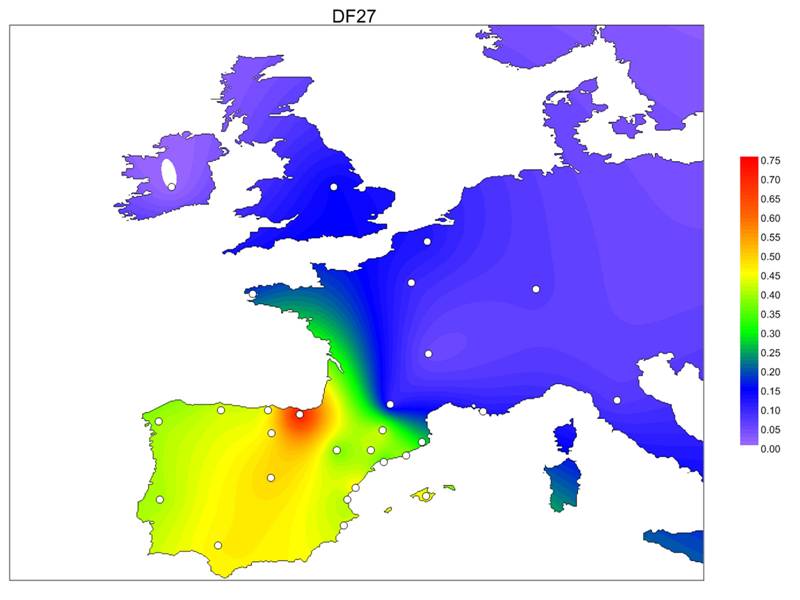40% of Spanish and Portuguese men descend from a common ancestor who lived 4,500 years ago
40% of Spanish and Portuguese men descend from a common ancestor who lived 4,500 years ago

It only accounts for 1% of all the male genome, but it is responsible for men being anatomically male. The Y chromosome, whose mission is to prevent the formation of ovaries in the foetus and allow the development of testes, is passed only from fathers to male offspring. From the evolutionary point of view, this feature facilitates tracing the different existing variations of the chromosome, and the origin, dispersal and geographical distribution of many of them are already known. Now, researchers at the Institute of Evolutionary Biology (IBE), a joint centre of Pompeu Fabra University and the CSIC, and the University of the Basque country (UPV/EHUS) have studied the R1b-DF27 Y chromosome, known among the scientific community for its high frequency in the Iberian Peninsula.
By analysing DNA samples from almost 3,000 men from the Iberian Peninsula and France, the scientific team has revealed that this variant is present in 40% of Iberian men and 70% of men in the Basque Country. Beyond the Pyrenees, only 10% are carriers of the variant of the R1b DF27- Y chromosome.
According to Francesc Calafell, leader of the study and full professor with the Department of Experimental and Health Sciences at UPF, “the evolutionary history of the human Y chromosome appears to have occurred in bursts, with increases in the frequency of some variants in the wake of lifestyle shifts and technological innovations“. In the case of R1b-DF27, the authors assert that it originated between 4,000 and 4,500 years ago, and most likely appeared in the North-East of the peninsula. “Despite its current high frequency in the Basque Country, internal measures of diversity and age estimates are lower in the Basques than in any other people, which thus rules out this region as the source of the variant”, comments Calafell. A local source in Iberia would be the most plausible hypothesis, since this region “displays the greatest estimates of diversity and age via R1b-DF27“. These observations seem to agree with the movement from east to west that occurred in Iberia during the Bronze Age, when non-Indo-European Iberian peoples settled on the Mediterranean coast and in the interior because the Celtic peoples occupied the centre and the west of the Iberian Peninsula.
Genetics, a useful tool not only in the field of history
The study of R1b-DF27 may help trace migratory events involving Spanish or Portuguese men. One clear example has been seen in Latin American populations, where the variant is found at frequencies of 40% in Colombia, 36% in Puerto Rico, 10% in Mexico and 8% in Peru. The presence of R1b-DF27 is noticeably lower in populations with a stronger indigenous component, such as Mexico and Peru, which highlights a lesser mix of their individuals with the historical settlers. Even in Europe, the frequencies of the Y sub-groups have been used to detect short-term migratory events. Thus, the traces left by the medieval expansion of the Kingdom of Aragon to the Mediterranean during the 14th and 15th centuries, or the Spanish occupation of Flanders in the 16th century can be traced via male lineages, in particular, through R1b-DF27.
A chromosome variation with relatively high frequencies in Iberian populations and that is rare in other regions such as R1b-DF27 may also have applications in forensic genetics. Its presence in a biological sample collected at a crime scene may help to identify the geographic origin of whoever contributed to it.
Finally, the Y chromosome is often used in studies related to family name(s), since they are also usually passed down via the male line. For this reason, Y chromosome subgroups are analysed and, considering their similarity among men who share the same family name, a common genealogical origin is established.
Reference article: Neus Solé-Morata, Patricia Villaescusa, Carla García-Fernández, Neus Font-Porterias, María José Illescas, Laura Valverde, Francesca Tassi, Silvia Ghirotto, Claude Férec, Karen Rouault, Susana Jiménez-Moreno, Begoña Martínez-Jarreta, Maria Fátima Pinheiro, María T. Zarrabeitia, Ángel Carracedo, Marian M. de Pancorbo & Francesc Calafell. Analysis of the R1b-DF27 haplogroup shows that a large fraction of Iberian Y-chromosome lineages originated recently in situ. Scientific Reports, August 2017. DOI: s41598/online-017-07710-x
Picture: Frequencies of DF27 in Iberian and European populations - UPF
